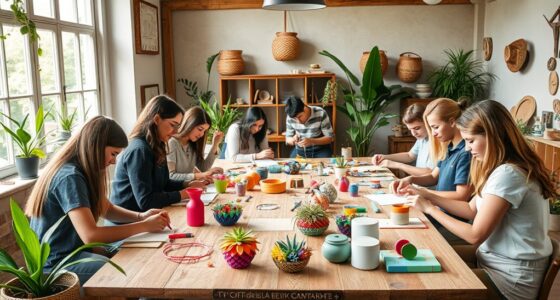Social impact by design means intentionally creating solutions that promote equity and empower communities. You focus on understanding local needs and involving community members early in the process. This approach combines sustainable methods with inclusive participation to foster trust and ownership. By aligning your design efforts with community goals, you can build lasting change that benefits everyone. Keep exploring how to turn these principles into actionable strategies for meaningful social impact.
Key Takeaways
- Strategic design prioritizes community needs, fostering inclusive solutions that promote equity and long-term social empowerment.
- Engaging community members early ensures designs reflect local values, building trust and ownership.
- Sustainable solutions minimize environmental impact while maximizing social benefits and resource accessibility.
- Designers facilitate ongoing collaboration, adapting projects to evolving community goals and fostering a sense of pride.
- Transforming design into a community-led movement empowers residents and creates resilient, socially equitable outcomes.

Have you ever wondered how intentional design can create meaningful social change? When you approach projects through a lens of social impact, you realize that thoughtful, strategic planning isn’t just about aesthetics or functionality—it’s about shaping a better world. At the heart of this approach is the idea that design can foster sustainable solutions that address real community needs. It’s not enough to create something that looks good; it has to work for the people it’s meant to serve, ensuring longevity and adaptability. Sustainable solutions mean designing with materials, methods, and systems that minimize environmental impact while maximizing social benefits. This requires a deep understanding of the community’s context, resources, and aspirations, so that every element of your design contributes to long-term well-being.
But sustainable solutions alone aren’t enough. Community engagement plays a critical role in ensuring that your design truly resonates and delivers impact. When you involve community members early in the process, you gain insights that can’t be found through surveys or data alone. Their lived experiences, cultural values, and daily routines shape the design in meaningful ways. Engaging with the community isn’t just a box to check; it’s a continuous dialogue that builds trust, fosters ownership, and encourages shared responsibility for the project’s success. You might hold workshops, focus groups, or informal conversations—whatever method best facilitates genuine participation. The goal is to empower community members, making them active collaborators rather than passive recipients. When people feel heard and involved, they’re more likely to support and sustain the initiative long after its initial implementation.
This collaborative approach transforms design from a top-down process into a community-led movement. It’s about recognizing that those who are most affected by your work should have a say in its creation. By blending sustainable solutions with community engagement, you create projects that are not only environmentally responsible but also socially inclusive. These projects can improve access to resources, elevate local voices, and foster a sense of pride and ownership. As a designer or innovator, your role is to facilitate this process—listening, adapting, and ensuring that your work aligns with the community’s goals. Ultimately, social impact by design isn’t just a concept; it’s a practice that requires intentionality, empathy, and a commitment to lasting positive change. Incorporating knowledge of traditional and modern techniques, such as butter making, can also serve as a metaphor for transforming community assets into sustainable and culturally meaningful initiatives.
Frequently Asked Questions
How Can Design Processes Be Made More Inclusive?
You can make design processes more inclusive by actively incorporating participatory methods that involve diverse community members throughout each stage. Emphasize cultural sensitivity to respect different backgrounds and perspectives, guaranteeing everyone’s voice is heard and valued. By fostering open communication and collaboration, you create solutions that truly address community needs. This approach builds trust, promotes equity, and ensures the design process benefits all stakeholders equally.
What Are Common Barriers to Community Engagement?
Barriers to community engagement are like walls blocking connection. You often face the digital divide, where limited internet access keeps some voices silent. Trust building takes time, and without it, community members may hesitate to share honest feedback. Additionally, language differences or past negative experiences can create skepticism. Overcoming these hurdles requires patience, genuine effort, and inclusive strategies to foster open dialogue and build lasting relationships.
How Do You Measure Social Impact Effectively?
You measure social impact effectively by combining impact metrics with qualitative assessments. Start by tracking clear, quantifiable outcomes relevant to your goals, like increased access or improved well-being. Then, gather stories and feedback from community members to capture nuanced changes that numbers might miss. This approach guarantees you get an extensive picture of your impact, allowing you to adjust strategies and demonstrate real community benefits.
What Role Does Cultural Context Play in Design?
You might think cultural context isn’t vital in design, but it’s essential. Cultural nuances influence how people perceive and interact with your work, so you should prioritize understanding traditions and societal values. By integrating tradition and respecting local customs, you create solutions that resonate deeply and foster community trust. Ignoring this can lead to miscommunication or rejection, while embracing cultural context makes your design more meaningful and impactful.
How Can Organizations Sustain Community Empowerment Initiatives?
You can sustain community empowerment initiatives by developing strong partnership strategies that foster collaboration and trust. Seek diverse funding models, including grants, donations, and social enterprise income, to guarantee financial stability. Engage community members in decision-making, demonstrate measurable impact, and adapt programs based on feedback. Regularly assess your initiatives’ effectiveness to maintain relevance and support, ensuring long-term empowerment and positive social change.
Conclusion
So, here you are, thinking design alone will solve society’s biggest issues. Ironically, it’s not just about fancy visuals or clever ideas—it’s about truly understanding and empowering communities. You might craft the perfect solution, but without genuine engagement, it’s all just surface deep. Remember, real social impact isn’t about design for design’s sake; it’s about designing for those who need it most—sometimes, that means listening more than creating.









